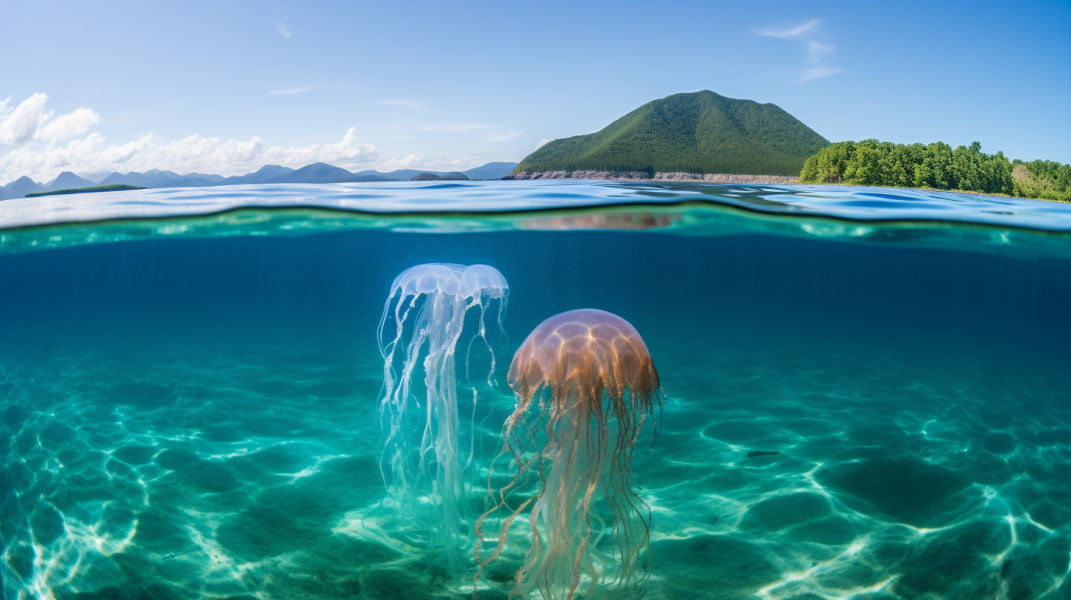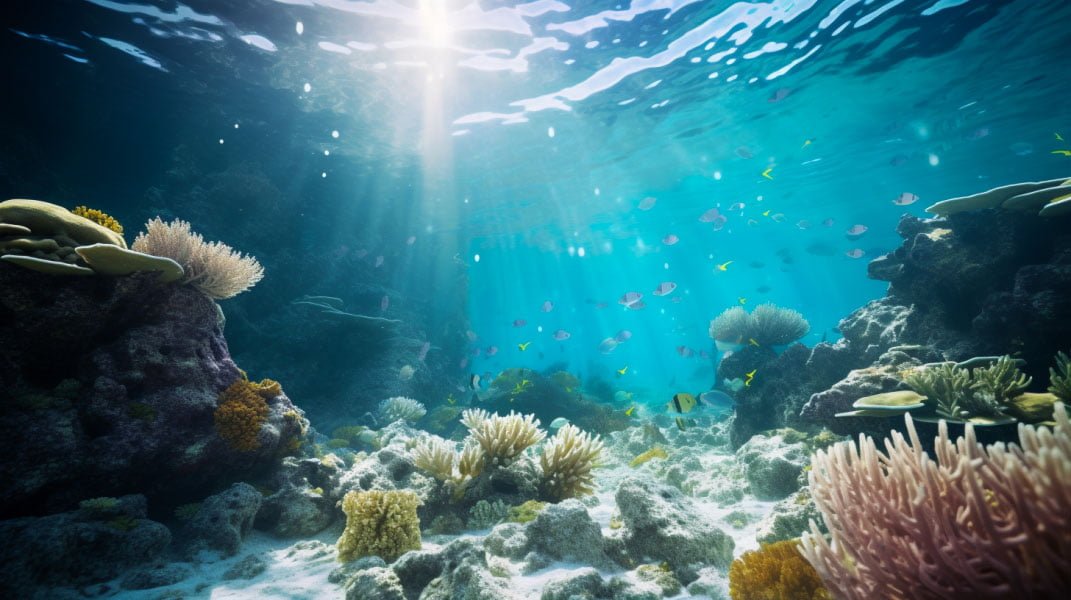Whitsundays Stinger Season

As the temperature rises, so does the risk of encountering a potentially dangerous marine stinger in the Whitsundays. But dont worry, as an old skipper once told me …
“Stinger suits are like wearing a seatbelt in a car, the chance is low you will need it, but if needed, it will save your life.”
Understanding the risks and taking the necessary precautions when entering the water during the stinger season is essential.
From box jellyfish to Irukandji, this article will provide an overview of what to expect and how to protect oneself in the Whitsundays during the stinger season.

What to Know About Stinger Season in the Whitsundays
With its warm tropical waters providing favourable conditions for marine stingers, the Whitsundays are on high alert during Stinger Season, which runs from late October to May. However, this does not necessarily mean visitors cannot safely enjoy the area during this time. It is recommended that those looking to explore the space speak with the knowledgeable crew about the day’s conditions and take appropriate safety precautions, such as wearing a stinger suit.
Box jellyfish and Irukandji are the harmful stingers in the Whitsundays, while harmless jellyfish species such as moon and crystal jellies can also be found. Pregnant women, the elderly, and children may opt for additional protection. Carrying vinegar in the event of a sting is also recommended, especially when swimming on unpatrolled beaches.
The chances of being stung by a marine stinger in the Whitsundays and Airlie Beach are scarce, with hundreds of thousands of people entering the waters each year with few incidents. Nonetheless, taking preventive measures allows locals and visitors to enjoy the water at all times of the year. Following the necessary safety precautions and being aware of the conditions, visitors can have a safe and enjoyable experience in the Whitsundays during the Stinger Season.
Chances of Being Stung in the Whitsundays
Being stung during the Whitsundays stinger season is rare most years, with hundreds of thousands of people entering the waters every year and few incidents.
Preventive measures such as wearing a stinger suit and carrying vinegar can ensure a safe and enjoyable experience.
Located in the warm tropical waters of the Whitsundays, the chances of being stung by a marine stinger are meagre when the necessary precautions are taken. This is demonstrated by the hundreds of thousands of people entering the waters yearly, with very few recorded stinger incidents.
Even during peak stinger season, the risk of being stung is minimal when the proper safety measures are employed.
With the proper knowledge and gear, the Whitsundays remain a haven for visitors and locals alike.

Types of Stingers in the Whitsundays
Several species of marine stingers are present in the Whitsundays, including box jellyfish, Irukandji, moon jellies, and crystal jellies.
Box jellyfish can be recognised by their sizeable cubed bell and long tentacles, while Irukandji is much smaller, roughly the size of a fingernail and translucent.
Bluebottles, however, are dark blue and have a bottle-shaped bell.
Moon jellies and crystal jellies, while also present in the waters, are harmless and rarely sting.
It is essential to be aware of the type of jellyfish present in the Whitsundays and take all necessary precautions to avoid stings.
Wearing a stinger suit is necessary and can help minimise the sting risk.
Swimming Safely and Enjoying the Whitsundays
Visiting the Whitsundays offers a unique opportunity to explore the beautiful ocean and Great Barrier Reef marine life while swimming safely and enjoying the region. Taking the necessary precautions is essential to having a safe and enjoyable experience.
Wearing a stinger suit is the most vital step to protect against stings, and these can be provided on tour for those who are not comfortable bringing their own. Additionally, carrying vinegar in case of stings is always a good idea, especially when swimming on unpatrolled beaches.
It is also important to know the day’s winds and conditions, and if on a Whitsunday tour, ask the experienced crew for advice.
With the proper preparation, the Whitsundays can be an excellent destination for those looking to explore its unique beauty safely.
For more information on Marine Stingers in North Queensland, see Surf Life Saving Queensland advice here
FAQ
How Long Does The Whitsundays Stinger Season Last?
Marine stinger season in the Whitsundays runs from late October to May. It is recommended to speak with knowledgeable crew about the day’s conditions. Wearing a stinger suit is always a good idea.
What Should I Do if I Am Stung by a Marine Stinger?
If stung by a marine stinger in the Whitsundays, seek medical attention immediately. Apply vinegar to the affected area to reduce the severity of the sting.
What Are the Safest Swimming Spots in the Whitsundays?
The safest swimming spots in the Whitsundays are sheltered bays, calm beaches, and stinger net beaches.
Are Medical Facilities Available if a Marine Stinger Sting Is Serious?
Yes, medical facilities are available if a marine stinger sting is serious. Emergency medical services are accessible to treat more severe stings and can provide quick medical attention. It is important to take necessary precautions and seek medical attention if necessary. The crew onboard the boats are trained to treat stings, there is also a medical centre on Hamilton Island.
Are There Any Other jellyfish in the Whitsundays That Could Pose a Risk?
The Whitsundays is home to several jellyfish that may pose a risk. These include box jellyfish, Irukandji, moon jellies, crystal jellies and bluebottles. Taking necessary precautions, such as wearing a stinger suit and carrying vinegar, helps minimize the risk of being stung.
[forminator_form id=”244492″]
Hi, I’m Nath J, a long-time local who’s been lucky enough to live and work tourism in the Whitsundays since 2001.
Over the past two decades, I’ve helped visitors discover the best of this incredible region, from Whitehaven Beach and Hill Inlet to the hidden spots only locals know about. I started out managing boats and tours, and these days I run Ripple Effect Online, a tourism-focused digital marketing business helping local operators grow and connect with travellers like you.
I’ve written an ebook called Whitsunday Islands: A Journey through Paradise, created countless local travel guides, and earned recognition as a “Whitsundays Tourism Hero” from QTIC for my contribution to the region and gained First Nations Cultural Protocol training through QTIC as well. But more importantly, I’ve spent years listening to travellers, understanding what makes a trip unforgettable, and helping people plan the kind of experience they’ll talk about for years.
If you’re planning a visit to Whitehaven Beach or anywhere in the Whitsundays, I’m here to help you make it amazing.
Find me on Facebook and LinkedIn or drop me an email at info@nath-j.au.
